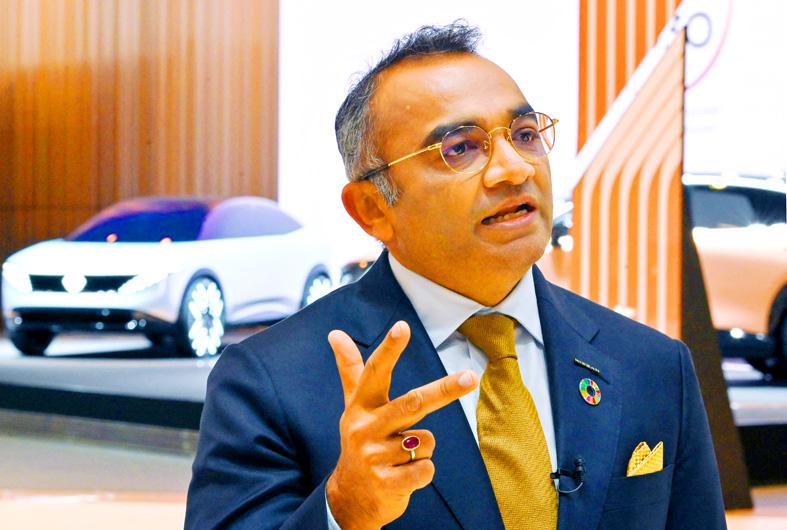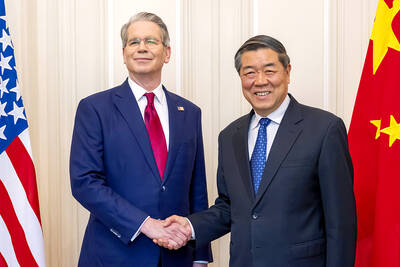Factory production in Japan in October edged up, ending a three-month slide and adding to signs that a global supply-chain crunch might have been easing before the emergence of the Omicron variant of SARS-CoV-2.
Higher output of vehicles and factory equipment lifted overall production 1.1 percent from September, the Japanese Ministry of Economy, Trade and Industry reported yesterday.
Manufacturers said that they plan to boost output again last month and this month, a good sign for Japan’s recovery this quarter.

Photo: AFP
Analysts had expected a 1.9 percent increase in October.
A separate report showed continued resilience in the labor market, with the unemployment rate ticking down to 2.7 percent and a measure of demand for workers showing positions on offer still outnumbering jobseekers.
While Japan’s manufacturing gains and positive production forecasts offer more evidence that Asia’s supply-chain shortages might be easing, the Omicron variant has reignited fears that a worst-case scenario could necessitate a return to growth-crippling lockdowns.
Japan yesterday closed its borders to new foreign arrivals, a move coming only weeks after the country managed to loosen restrictions amid plummeting case counts.
“If Omicron is found within Japan and triggers more restrictions, it could shift the recovery trajectory, but so far that doesn’t seem to be happening,” Itochu Research Institute economist Atsushi Takeda said. “September appears to have been the bottom for production.”
Bank of Japan Governor Haruhiko Kuroda on Monday said that he expects Japan’s economy to return to growth in the coming months, signaling that the emergence of Omicron had not changed his outlook much.
October’s production gain came as a shortage of parts from Asia began to ease and vehicle output increased for the first time in four months, a ministry official said.
Reports from Toyota Motor Corp showed that the group raised domestic output by about 22 percent in October, although the automaker’s global output is still down by more than one-quarter from last year’s level.
Manufacturers surveyed in yesterday’s report said that they plan to increase output by 9 percent last month and another 2.1 percent this month, but the reported plans tend to be overly optimistic and the survey was conducted before Omicron was discovered.
Semiconductor supplies also continue to be a problem.
Nissan Motor Co president Makoto Uchida said in an interview with Bloomberg Television this week that the company had expected to recover from shortages in the second half of the fiscal year, but he had become less optimistic.
The firm last month cut its sales plan for this year by 600,000 units due to continuing shortages.

RECYCLE: Taiwan would aid manufacturers in refining rare earths from discarded appliances, which would fit the nation’s circular economy goals, minister Kung said Taiwan would work with the US and Japan on a proposed cooperation initiative in response to Beijing’s newly announced rare earth export curbs, Minister of Economic Affairs Kung Ming-hsin (龔明鑫) said yesterday. China last week announced new restrictions requiring companies to obtain export licenses if their products contain more than 0.1 percent of Chinese-origin rare earths by value. US Secretary of the Treasury Scott Bessent on Wednesday responded by saying that Beijing was “unreliable” in its rare earths exports, adding that the US would “neither be commanded, nor controlled” by China, several media outlets reported. Japanese Minister of Finance Katsunobu Kato yesterday also

Jensen Huang (黃仁勳), founder and CEO of US-based artificial intelligence chip designer Nvidia Corp and Taiwan Semiconductor Manufacturing Co (TSMC, 台積電) on Friday celebrated the first Nvidia Blackwell wafer produced on US soil. Huang visited TSMC’s advanced wafer fab in the US state of Arizona and joined the Taiwanese chipmaker’s executives to witness the efforts to “build the infrastructure that powers the world’s AI factories, right here in America,” Nvidia said in a statement. At the event, Huang joined Y.L. Wang (王英郎), vice president of operations at TSMC, in signing their names on the Blackwell wafer to

‘DRAMATIC AND POSITIVE’: AI growth would be better than it previously forecast and would stay robust even if the Chinese market became inaccessible for customers, it said Taiwan Semiconductor Manufacturing Co (TSMC, 台積電) yesterday raised its full-year revenue growth outlook after posting record profit for last quarter, despite growing market concern about an artificial intelligence (AI) bubble. The company said it expects revenue to expand about 35 percent year-on-year, driven mainly by faster-than-expected demand for leading-edge chips for AI applications. The world’s biggest contract chipmaker in July projected that revenue this year would expand about 30 percent in US dollar terms. The company also slightly hiked its capital expenditure for this year to US$40 billion to US$42 billion, compared with US$38 billion to US$42 billion it set previously. “AI demand actually

RARE EARTHS: The call between the US Treasury Secretary and his Chinese counterpart came as Washington sought to rally G7 partners in response to China’s export controls China and the US on Saturday agreed to conduct another round of trade negotiations in the coming week, as the world’s two biggest economies seek to avoid another damaging tit-for-tat tariff battle. Beijing last week announced sweeping controls on the critical rare earths industry, prompting US President Donald Trump to threaten 100 percent tariffs on imports from China in retaliation. Trump had also threatened to cancel his expected meeting with Chinese President Xi Jinping (習近平) in South Korea later this month on the sidelines of the APEC summit. In the latest indication of efforts to resolve their dispute, Chinese state media reported that